Project date: 1999-2001
Given the growing security problems that non-governmental NGOs are faced with when undertaking humanitarian and other tasks, the UIA decided to undertake a study of the protection such organizations require when undertaking hazardous duties. The evaluation of this situation was conducted via a survey to "on the spot" personnel themselves. This questionnaire was prepared in collaboration between the UIA and the University of Paris 2, and the results published in the UIA's journal Transnational Associations in 1999.
Background
NGO Security: UIA studies in security issues for international organisations working in hazardous situations, by Allan Howard (October 2001), is an overview presentation on hazardous mission security, which outlines the need and context for the survey.
Other security-related UIA presentations
- Information warfare (2000)
- Meeting security (2001)
NGO Security Survey Results - English
Protection for non-governmental organisations on hazardous duties
Report on the results of a UIA survey
by Mario Bettati (note 1)
Well aware of the growing security problems that non-governmental organisations have to face when undertaking humanitarian and other tasks, the Union of International Associations (UIA) has decided to proceed with a study of protection that such organisations require when undertaking hazardous duties, by means of a specific evaluation of the situation as perceived by "on the spot" persons concerned themselves. A questionnaire was prepared for this purpose under our own scientific management, with participation by our team from the University of Paris 2 and in cooperation with the working group from the UIA.
Amongst those non-governmental organisations that replied, some indicated that their activities were not such as to entail "hazardous duties". They were not therefore faced with the problems covered by the questionnaire and, for the same reason, were unable to provide the information requested. Others, such as a leading humanitarian bodies, objected that they did not regard themselves as non-governmental organisations and, while it was true that they had had to encounter serious security problems, they did not wish to answer our questions. Those who agreed to answer them in detail sometimes appended documents to their return indicating their status, main activities and/or a brief history of their tasks.
Having regard to the objectives pursued, which determined the structure of the questionnaire, it was inevitable that each non-governmental organisation should have to make a number of choices when answering each type of question. The results, on passing through a data processing procedure, therefore displayed proportions in terms of quantities and values that varied absolutely in relation to the open question put and to the distribution of the number of replies, itself varying according to subject. The analysis set out below follows the order of the questions and uses the headings printed in the questionnaire. (note 2)
- Your scope of work
- Your area of work
- Your field of work
- Type of incidents that have affected YOUR association since 1990
- Actions obstructing the proper discharge of dutie
- Barred access to victims
- Administrative obstacles to victim access
- Obstacles to the delivery of goods and supplies
- Restrictions on freedom of movement
- Violence directed against property
- Against convoy
- Looting
- Attacks against the association’s vehicles
- Type of losses sustained by convoys
- Against premises
- Looting
- Attacks against the association’s installations
- Type of loss sustained
- Violence directed against persons
- Arrest - detention - kidnapping
- Physical injury
- Causes of death or injury
- Your assessment of protection at the present state of international law
- Do you feel satisfied with your present status as a non-governmental organisation with regard to security?
- Should an improvement in the rules of international law be aimed at: …
- Have you arrived at understandings, an agreement or arrangements with local authorities with a view to protection?
- Have you had recourse to private security-men for protection purposes?
- In what areas do you consider it necessary for the international community to take the initiative to improve protection for non-governmental organisations and that for its own members?
- In what areas do you consider it necessary for the international community to take initiatives towards improving protection for your association’s property?
The questionnaire asks the non-governmental organisations questioned to spell out their work sector within the area in which they operated.
As far as the operational speciality of the non-governmental organisations studied is concerned, the replies show a clear emphasis on development aid. This finding is increased if those of the replies that were classified as "other" are added; they included agriculture, reconstruction, economic reform, mine clearance and the environment. The heading "Human Rights" could also be usefully extended, since certain organisations included the work they do amongst refugees, immigrants and displaced persons and journalists in the "Others" category. This redistribution would not alter the initial classification, which places particular emphasis on development and human rights as soon as the "Others" sectors, which would be extensively reduced by a redistribution, are left to one side. Activities in defence of human rights are placed in second position - subject to the offsetting mentioned above - amongst the non-governmental organisations preoccupied with a lack of security. This is confirmed by the recent resolution of the Human Rights Commission of the United Nations, which was due to be adopted by the General Assembly, on protection for the protectors of the fundamental rights of the individual.
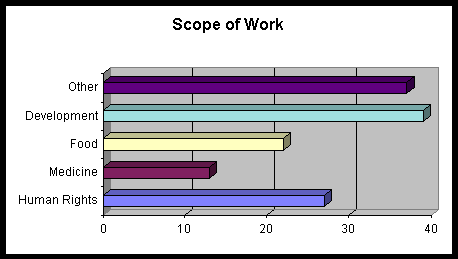
One notes that the organisations stating that medical activities are included are altogether the least numerous, which waters down the effect of the high profile they enjoy in the public mind, where they are believed to be more exposed because more than most they are in the front line in conflict areas.
The results obtained by sampling with regard to the location of non-governmental organisations’ activities and therefore implicitly the location of risks - since the associations who replied are those that are beset by the problems of protecting their members or their property - came as no surprise.
In fact, it is not in the countries of Western Europe or in North America that destitution, the defence of human rights and famine relief are the most pressing topics, even though the work done there is far from negligible. It is, therefore, hardly surprising to see that a high proportion of work is done in Africa, Asia and Latin America. Twice as much work is done in relation to any other area in Africa alone.
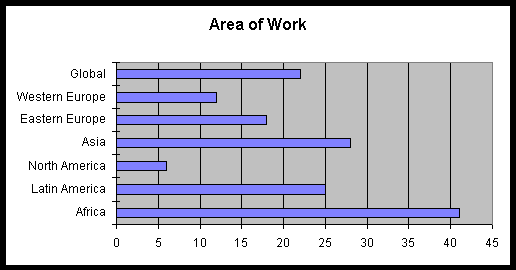
Under this heading, the associations questioned were asked to distinguish between incidents obstructing the proper conduct of duties, where the effect was simply to delay them, to defer them or to complicate their execution, from acts of violence directed against property or persons that had the same effect but with far more serious consequences for individuals and equipment as far as the harmful effects of actions were concerned.
These varied in nature. From prevention of access to victims to administrative obstacles to access, with obstruction to the delivery of goods and supplies and restrictions on movement in between.
While at humanitarian level, the nature of conflicts has changed and rebel movements are more likely than government forces to cause obstruction, it is clear that in other fields of activity, especially in development aid or in defence of human rights, government authorities remain the principal interlocutors. It is therefore not really surprising that they are the principal source of difficulties of access.
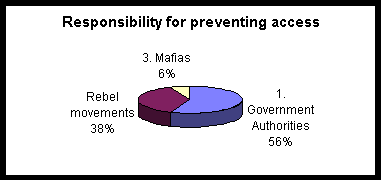
While at humanitarian level, the nature of conflicts has changed and rebel movements are more likely than government forces to cause obstruction, it is clear that in other fields of activity, especially in development aid or in defence of human rights, government authorities remain the principal interlocutors. It is therefore not really surprising that they are the principal source of difficulties of access.
Non-governmental organisations have become a source of profit to a large number of protagonists, especially - but not only - in developing countries. The wealth - sometimes ostentatious - of their resources, the distribution that they undertake, and the stocks that they have amassed for this purpose are often a source of temptation for the public or private agencies who have a smidgen of power and who use it to draw some material advantage by taking samples. This explains why the obstacles most frequently mentioned are extensive delays at a checkpoint and requests for payment. The latter demand is most commonly made together with the former. These are the two most frequent obstacles.
But the administrative obstacles are not always dictated by avarice. It also happens that associations come up against refusals to provide visas or delays at the frontier for political or bureaucratic reasons. Delays are relatively less frequent than they used to be, but refusal of a visa is still a considerable problem.
The United Nations has on numerous occasions since the early nineties demanded freedom of access to humanitarian aid for victims in connection with the various internal conflicts in which the UN has been concerned. We know, for example, that the Security Council adopted 114 resolutions on these lines between 1990 and October 1998. The wordings of the resolutions vary but their content is the same as that found in Resolution 1193 of 28 August 1998 concerning Afghanistan where it "… requires of all Afghan factions, especially the Taliban, to do everything possible to guarantee the safety and freedom of circulation of personnel of the United Nations and other international and humanitarian organisations…" (note 3)
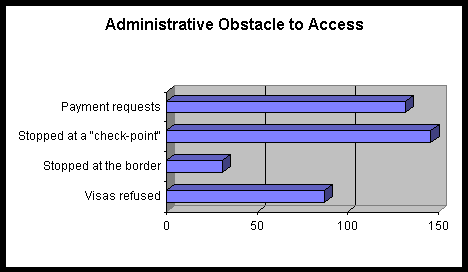
It is obvious from the outset that the main factors preventing the delivery of goods and supplies are administrative formalities. They are all the more feared by the associations where their field of work requires them to take urgent action. Secondly, a finding which supports that which we have set out in the pie chart above, is that "taxation", i.e. a request for payment or sampling from lorry loads, is also one of the major bug-bears complicating associations’ actions on the ground.
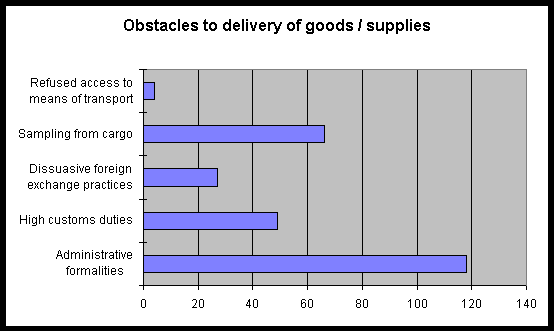
These restrictions are not a prime concern. They are spread fairly uniformly amongst the various categories of obstacle, with a low point where the withholding of residence permits is concerned, which ultimately is less widespread than the other difficulties. The important position occupied by threats or assaults will be noted. They stress, should it be necessary, the breadth of risks run by the organisations and their personnel. Finally, a third source of restrictions is the establishing of forbidden areas which, as we know, may be imposed as often by national and local authorities as factions controlling a region.

A distinction can be drawn between violence against convoys and violence against premises.
A distinction must be made between looting strictly speaking and armed attack against vehicles, while listing the main categories of loss sustained.
The persons responsible for looting are divided uniformly amongst public authorities, insurgent movements, and ordinary criminals. This means that the public authorities represent only one third of the sources of insecurity, which makes it far more difficult for the United Nations to impose injunctions on them, since, the weaker or more delinquent a country’s government, the harder it is for its public authorities to control insurgents or ordinary criminals.
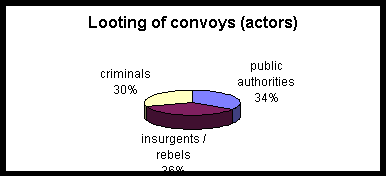
We know that non-governmental organisations for the most part use land vehicles, which explains why there have been no attacks on shipping. There have been only two against helicopters and two against aircraft. This difference and the rest of the results call for no comment.

The distribution of losses in relation to the degree of harm done similarly provides information which is self-explanatory. The substantial proportion of total destruction (28%) compared with partial destruction (43%) is noteworthy.
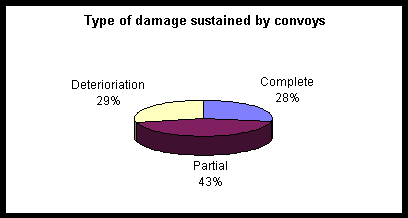
Three series of questions were put in the questionnaire, the first concerning those responsible for looting, the second concerning attacks on the association’s installations, and the third concerning the type of damage sustained.
The results here are appreciably different from those concerning persons responsible for tax on convoys. The public authorities’ share in them is very much smaller (19% as against 34%). That of insurgents altogether higher (50% as against 36%).
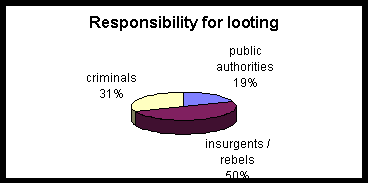
The points of the survey reveal a predominance of attacks against dwellings and offices. Having regard to the wide variety of activities undertaken by the non-governmental organisations questioned, it is going too far to say that the attackers’ objectives were altogether more political than self-seeking or inspired by gain. But it is by no means impossible, either, that the target was selected both as a centre of decision-making and representing the association concerned, and as a source of profit linked to the presence of expensive equipment (data processing, office automation and communication).
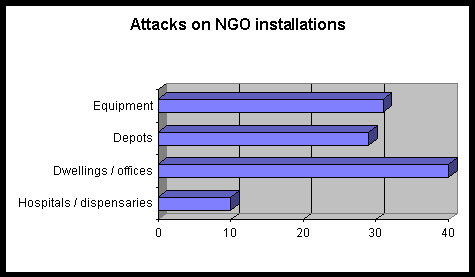
The replies provide the same pointers as those concerning damage sustained by convoys, within 2% or 3% almost. This is perfectly understandable insofar as vulnerability is much the same, whether the goods are stationary or mobile.
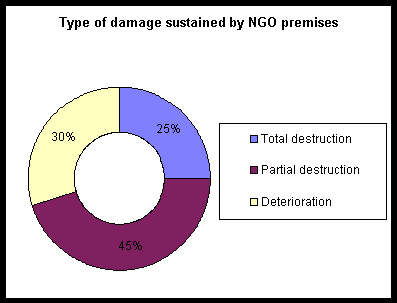
The questionnaire asked the associations consulted to provide information on arrests, detention and kidnapping, physical attack, and the reasons for death and injury.
Replies concerning identification of persons responsible for arrests, detentions and kidnapping are out of line with those received concerning convoys and premises. Ordinary criminals are twice as less likely to undertake these actions against persons, government authorities and insurgents being held equally responsible, at 43% and 45% respectively. This is easily explained by the methods, the purposes and the consequences of these kidnappings, which are more within the capability of organisations of a political nature, equipped with human and institutional resources but endowed with a minimum of structural power.
Physical injury is naturally the most serious risk, and that giving rise to the deepest worries regarding security on the ground.
The proportions as between the five categories adopted are all the more alarming since murder, which is placed in second position after degrading treatment, is quite common and, together with the latter, is the main purpose of attacks.
The search for solutions on the part of non-governmental organisations echoes that of the inter-governmental organisations, namely the United Nations (note 4) or the European Union. The United Nations’ findings can be transposed to non-governmental organisations. "The erosion of respect for humanitarian values has led to an increase in the number of civilian victims; it has intensified the need for protection and aid for refugees and other persons affected by a conflict; it has complicated the provision of humanitarian assistance and aggravated the risks facing aid workers."
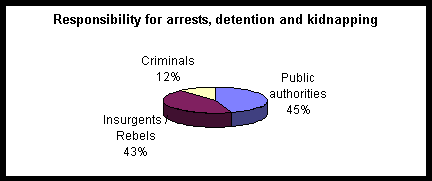
Dominated by fire from automatic weapons and accidents, the causes of death and injury seem to follow an almost equal distribution amongst aggressors and the victims with regard to the physical assault sustained. Such a conclusion would be hasty and incorrect. In fact, although the share of accidents could indisputably be reduced by better preparation and better training of non-governmental organisations’ staff deployed in the field (and we know that nearly all of them work on setting up and imparting preventive and precautionary measures (note 5)), one should add to shooting from automatic weapons bombardment, anti-personnel mines, anti-tank mines and "miscellaneous weapons" a common factor of which is that they are used or deployed by one and the same category of protagonists: the combatants.
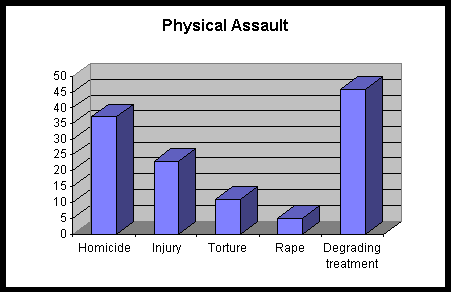
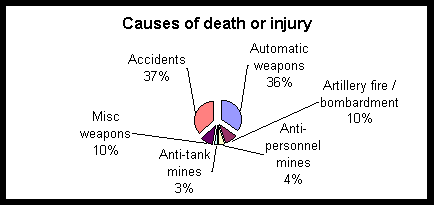
The associations seem to expect a great deal from international law since, obviously, the survey reveals a broadly shared desire to see the legal rules promulgated by the Community of States modified so as to strengthen protection.
Practically half of the associations that replied (48%) considered their status to be unsatisfactory with regard to security. This is relatively important and appears to indicate that the question requires some thought both at UIA and governmental and inter-governmental levels.
This is more especially so since only 42% of them feel that their status is satisfactory and 10% have no view. This observation is strengthened by the replies to the following question, put in the questionnaire.

In effect, a large proportion of replies shows that it is in fact with regard to the international status of non-governmental organisations that requests for legal reform are most frequently heard. Within their status, it is hardly surprising to see the list of concerns headed by protection for the individual, followed by protection of property and lastly that of transport.
Pending solutions in international legislation that could effectively be implemented, empirical solutions are likely to remain the chief contemplatable measures for a long time to come. Their nature remains to be decided. Some could be consensual; others could rely on various kinds of force.

The first, pragmatic method has consisted fairly frequently of negotiating with the authorities on the spot and finding some accommodation, rapprochement or conciliation.
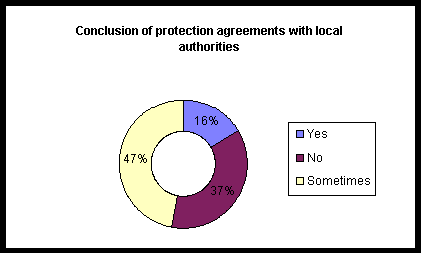
The general principle is against this. Private humanitarian organisations reject any cooperation with the armed forces of any party whatever. A lawyer specialising in humanitarian law reiterated in May-June 1992: "Were it to associate itself with one of the armed forces opposing or covered by it, the CICR would lose all credibility in its role as a neutral intermediary and any opportunity of fulfilling this role." (note 6) The situation, as we know, has been quite different in practice. Nearly one-third of the non-governmental organisations that replied (16% sometimes + 30% yes) confirmed they have had recourse to protection by private security-men. One must remember that in circles close to the UNO Secretary-General, there have been worries as to the effects produced by such a practice (large payments made by the humanitarian agency to armed bands who, moreover, had been holding the local population to ransom for some time; destruction of the last shreds of the social fabric through armed men making individual demands much greater than those of the country’s national or regional rulers; indirect financing of the arms market, etc.). It therefore seems difficult to regard such a practice as desirable, the more so since sampling shows that a large majority (71%) of the associations questioned undertaking hazardous duties have never contemplated this step.

Fully in line with the replies to the previous questions, it is clear that the associations want to see action from the international community towards improving the status of their personnel.
It remains to be seen as the group’s work continues what types of immunity or privilege should be introduced and within what limits steps that are acceptable to all parties to conflicts and crisis situations causing insecurity to the operators of these organisations could be envisaged.
One of the options under question "F" should logically have been placed under question "E". In fact, following an input error, F4 "Integrity of the person" appears under the heading of protection of property and not protection of persons. However, this slip has no effect on the result of the questionnaire. The replies clearly show that, as can only be expected, the organisations questioned attach their priorities to a desire both for integrity of the person and for the protection of property.


Conclusions
The worries expressed by the associations in their replies to the questionnaire - like those which for years have exercised the CICR, whose work in this connection is important - should not be ignored by the inter-governmental organisations who are now adopting a far more systematic attitude than in the past to questions of protection and security.
However, the work has been done relatively piecemeal or scattered in conjunction with the activities pursued by the UN or the European Union in another sector, connected sometimes with non-governmental organisations undertaking hazardous duties and sometimes in connection with security for their own staff. Some, but not all, of their comments can be transposed to the questions under consideration by the IAU. In fact, a report by the Secretary-General on Security of Personnel of the Organisation has been submitted at the United Nations to the Commission on Human Rights in connection with item 8 on the agenda concerning human rights for all persons subjected to some form of detention or imprisonment (note 7). We have in fact seen above (pages 61-62) that detention may be imposed by insurgents as well as government authorities. This report confirms the relevance of the recommendations made by Mrs Bautista, the Special Rapporteur of the sub-committee fighting against discriminatory measures and for the protection of minorities, with regard to United Nations personnel (note 8). At European level, ECHO has embarked on a preliminary study to test the water with various non-governmental organisations working with the European Commission on Security of Relief Workers and Humanitarian Space (note 9). This document was submitted on 18 May 1998 to the Council of Ministers of the European Union concerned with Development which decided to initiate a discussion on security in consultation with Member States. This document has been the subject of various comments by non-governmental organisations. It would be interesting to pool the conclusions obtained with those resulting from the work of the UN Sub-Committee, several recommendations of which seem to apply equally in the non-governmental or trans-national field. The UIA intends to entrust a working group with the preparation of a draft document that will take account both of the non-governmental organisations’ replies submitted and commented on above and of the various multilateral sources.
Notes:
- Professor at the University of Paris 2.
- Rather less than 100 replies were received. Questionnaires were despatched to 440 international associations. 98 replies were received, i.e. 22.27%.
- The countries or situations concerned in these 114 resolutions of the Security Council concerning access to victims are Afghanistan, Albania, Angola, Burundi, the former Yugoslavia, Georgia, the Gulf States, Gorny Karabakh, Liberia, Mozambique, the Central African Republic, Rwanda, Sierra Leone, Somalia, Tadjikistan, Yemen and Zaire.
- Cf. Report by the Secretary-General on protection for humanitarian aid activities for refugees and other persons affected by a conflict, S/1998/883 of 22 September 1998.
- Cf. Security in the Field. Information for staff members of the UN system, United Nations, New York, 1998, 66pp.
- SANDOZ (Yves) "Droit ou devoir d’ingérence, droit à l’assistance; de quoi parle-t-on?" Red Cross International Review, No. 795, May-June 1992, p. 231.
- E/CN.4/1998/33 27 February 1998
- E/CN.4 Sub.2/1992/19.
- ECHO working paper, Draft 8.2-19.2.98
NGO Security Survey Results - French
La protection des ONG en mission périlleuse
Rapport sur les résultats du questionnaire de l’UAI
par Mario Bettati
Consciente des problèmes croissants de sécurité auxquels sont confrontées les ONG dans leurs actions humanitaires et autres, l’Union des associations internationales (UAI) a décidé de procéder à une étude sur la protection des ONG en mission périlleuse à partir d’une évaluation concrète de la situation sur le terrain telle qu’elle était perçue par les intéressées elles-mêmes. A cette fin un questionnaire a été établi sous notre direction scientifique avec le concours de notre équipe de l’Université Paris 2 et en coopération avec le groupe de travail de l’Union des Associations Internationales.
Parmi les ONG qui ont répondu (note 1), certaines ont indiqué que leurs activités ne les conduisaient pas à assurer des « missions périlleuses ». Elles n’étaient donc pas confrontées aux problèmes faisant l’objet du questionnaire et, du même coup, dans l’impossibilité de fournir les renseignements demandés. D’autres, comme une importante organisation humanitaire, nous a objecté qu’elle ne se considérait pas comme une ONG et, bien que l’on sache qu’elle avait eu à connaître de graves problèmes de sécurité, ne souhaitait pas répondre à nos questions. Celles qui ont accepté d’y répondre de façon détaillée ont parfois joint à leur grille des documents indiquant le statut, les principales activités et/ou un bref historique de leurs missions.
Compte tenu des objectifs poursuivis qui ont déterminé la structure du questionnaire, il était naturel que chaque ONG opère plusieurs choix pour chaque type de question. L’exploitation informatique des résultats fait donc apparaître des proportions sur des quantités ou des valeurs absolues variables en fonction de la question ouverte posée et de la distribution du nombre des réponses, elle même variable selon les sujets. L’analyse qu’on va lire suit l’ordre des questions et reprend les intitulés qui avaient été adoptés dans le questionnaire.
- Votre domaine d’activité
- Votre secteur d’activité
- Votre zone d’activité
- Typologie des incidents dont votre association a été victime depuis 1990
- Actes d’obstruction au bon déroulement de la mission
- Interdiction d’accès aux victimes
- Obstacles administratifs à l’accès aux victimes
- Obstacles à la livraison des biens et fournitures
- Restrictions à la faculté d’aller et venir
- Violences dirigées contre les biens
- Contre les convois
- Pillage
- Attaques contre les véhicules de l’association
- Type de dommages subis par les convoi
- Contre les locaux
- Pillage
- Attaques contre les installations de l’association
- Type de dommages subis
- Violences dirigées contre les personnes
- Arrestation - détentions - enlèvements
- Atteintes à l’intégrité
- Causes de décès ou de blessures
- Votre évaluation de la protection en l’état du droit international
- Votre statut actuel d’ONG vous donne-t-il satisfaction sur le plan de la sécurité ?
- Une amélioration des règles de droit international devrait-elle porter sur:
- Avez-vous conclu des ententes, un accord ou arrangements avec les autorités locales aux fins de protection ?
- Avez-vous eu recours à des milices privées aux fins de protection ?
- Quels sont les domaines dans lesquels vous estimez nécessaire que la Communauté internationale prenne des initiatives en vue d’améliorer la protection des ONG et celle de ses membres ?
- Quels sont les domaines dans lesquels vous estimez nécessaire que la Communauté internationale prenne des initiatives en vue d’améliorer la protection de vos biens associatifs ?
Le questionnaire invitait les ONG interrogées à distinguer leur secteur d’activité de la zone dans laquelle elles opéraient.
En ce qui concerne la spécialité opérationnelle des ONG étudiées, les réponses montrent une nette prédominance de l’aide au développement. Ce constat s’amplifie si on y ajoute celles des réponses qui ont été classées comme « autres » et parmi lesquelles on trouve l’agriculture, la reconstruction, l’assainissement, le déminage ou l’environnement. Il conviendrait également d’amplifier la rubrique « droits de l’homme » puisque certaines ONG ont fait figurer dans la catégorie « autres » l’activité qu’elles mènent auprès des réfugiés, des migrants et des personnes déplacées ou des journalistes. Cette redistribution ne changerait pas le classement initial qui met en tête le développement et les droits de l’homme dès lors que l’on met à part les secteurs « autres », qui serait largement réduit par la redistribution. Les activités de défense des droits de l’homme sont - sous réserve de la compensation indiquée précédemment - en second rang parmi celles des ONG préoccupées par l’insécurité. Ce que confirme la récente résolution de la commission des droits de l’homme des Nations Unies, qui devrait être reprise par l’Assemblée générale, sur la protection des protecteurs des droits fondamentaux de la personne humaine.
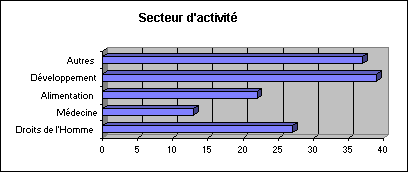
On observe que les ONG qui déclarent avoir des activité médicales sont finalement les moins nombreuses ce qui tempère l’effet de forte visibilité dont elles bénéficient dans l’opinion publique portée à les croire davantage exposées parce que plus spécialement en première ligne dans les zones de conflit.
Les résultats obtenus par le sondage en ce qui concerne la localisation des activités des ONG et donc implicitement la localisation des risques - puisque les associations qui ont répondu sont celles qui sont en proie à des problèmes de protection de leurs membres ou de leurs biens - ne doivent pas surprendre.
Ce n’est, en effet, pas dans les pays de l’Europe occidentale ou en Amérique du Nord que les besoins humanitaires, de défense des droits de l’homme ou en alimentation sont les plus aigus, même si les opérations qui s’y déroulent sont loin d’être négligeables. Il n’est, par conséquent, pas étonnant de constater une forte proportion d’activités en Afrique, en Asie et en l’Amérique latine. La première recevant, à elle seule presque le double de l’activité par rapport à chacune des deux autres.
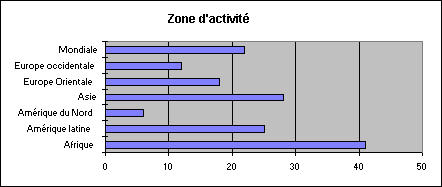
Dans cette rubrique, les associations interrogées étaient invitées à distinguer les actes d’obstruction au bon déroulement de la mission dont l’effet était simplement d’en retarder, d’en différer ou d’en compliquer l’exécution, des actes de violence dirigées contre les biens ou les personnes qui produisaient les mêmes effets mais avec des conséquences beaucoup plus graves sur le plan humain et matériel pour ce qui concerne la vulnérabilité des actions.
Ils peuvent être de diverses natures. De l’interdiction d’accès aux victimes aux obstacles administratifs à l’accès, en passant par les obstacles à la livraison de biens et de fournitures et les restrictions à la faculté d’aller et venir.
Bien que sur le plan humanitaire, la nature des conflits ait changé et qu’ils mettent aux prises davantage de mouvements de rébellion que de forces étatiques, il est clair que dans les autres domaines d’activité - notamment l’aide au développement ou la défense des droits de l’homme - les autorités étatiques demeurent les principaux interlocuteurs. Il n’est donc pas surprenant qu’elles soient la source principale de difficultés d’accès.
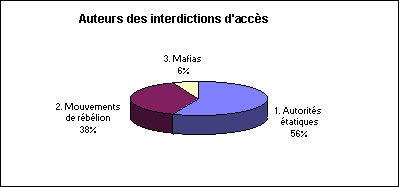
Les ONG sont devenues une source de profit pour un grand nombre d’acteurs, notamment - mais pas seulement - dans les pays en développement. L’opulence, parfois ostentatoire de leurs moyens, les distributions auxquelles elle se livrent, les stocks qu’elles constituent à cette fin, sont autant de tentation pour les agents publics ou privés qui détiennent fusse une parcelle de pouvoir et qui en usent pour tirer quelques avantages matériels par prélèvement. Cela explique que les obstacles les plus fréquemment évoqués soient la rétention prolongée à un check-point et la demande de paiement. La seconde étant, le plus souvent, formulée à l’occasion de la première. Ce sont les deux obstacles les plus fréquents.
Mais les obstacles administratifs ne sont pas toujours dictés par la cupidité. Il se peut également que, soit pour des raisons politiques, soit pour des raisons bureaucratiques les associations se heurtent à des refus de visa ou des rétentions à la frontière. On remarque que cette dernière est relativement moins fréquente tandis que le refus de visas constitue encore une difficulté considérable.
Les Nations Unies ont, depuis le début des années 1990, à de nombreuses reprises, exigé le libre accès de l’aide humanitaire aux victimes, à l’occasion des divers conflits internes dont elles ont eu à connaître. On sait, par exemple que le Conseil de sécurité a adopté, entre 1990 et octobre 1998, 114 résolutions dans ce sens. Les formulations de ces résolutions varient mais leur contenu est analogue à celle utilisée dans la Résolution 1193 du 28 août 1998 relative à l’Afghanistan où il "... Exige de toutes les factions afghanes, en particulier les Taliban, qu’elles fassent tout ce qui est possible pour garantir la sécurité et la liberté de circulation du personnel des Nations Unies et des autres organisations internationales et humanitaires ". (note 2)

D’emblée il apparaît que ce sont les formalités administratives qui, de loin, sont les principales sources d’entrave à la livraison de biens et fournitures. Elles sont d’autant plus redoutées par les associations, que leur secteur d’activité les conduit à œuvrer dans l’urgence.

En second rang, et cette constatation recoupe celle que nous avons dressée dans l’histogramme précédent, la « taxation », c’est à dire la demande de versement ou le prélèvement sur les cargaisons est également un des incidents majeurs qui pénalisent l’action des associations sur le terrain.
Ces restrictions ne revêtent pas un aspect dominant. Elles se répartissent de manière à peu près uniforme entre les différentes catégories d’entraves, avec un point bas concernant les interdictions de séjour qui sont finalement moins nombreuses que les autres difficultés. On notera la place importante que tiennent les menaces ou attaques. Elles soulignent, s’il en était besoin, l’ampleur des risques encourus par les ONG et leur personnel. Enfin, troisième source de restrictions l’établissement de zones interdites est, on le sait, tantôt le fait d’autorités nationales ou locales, tantôt de factions qui contrôlent une région.
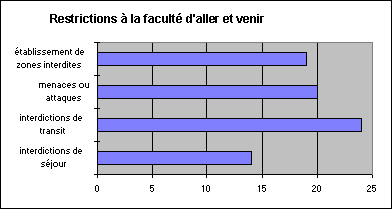
On distinguera violences contre les convois, et violences sur les locaux.
Il convient de distinguer le pillage proprement dit des attaques armées contre les véhicules puis de définir les grandes catégories de dommages subis.
Les auteurs de ces pillages se répartissent uniformément entre autorités publiques, mouvements insurgés et criminels de droit commun. Ce qui signifie donc que les autorités publiques ne représentent qu’un tiers des sources d’insécurité ce qui rend beaucoup plus difficile la tâche de l’O.N.U. qui souhaiterait leur adresser des injonctions, dans la mesure où, tant les insurgés que les criminels de droit commun sont d’autant moins contrôlables par les pouvoirs publics que l’État est faible ou déliquescent.

On sait que les ONG utilisent en grande majorité les transports terrestres ce qui explique qu’il n’y ait aucune attaque contre des embarcations. Il y en a deux seulement contre des hélicoptères et deux contre des avions. Cette différence et le reste des résultats n’appellent pas de commentaire.

La répartition des dommages en fonction du degré d’atteinte a fourni également des renseignements qui se suffisent à eux mêmes. On remarquera la part importante des destructions totales (28%) face aux destructions partielles (43%).

Trois séries de questions étaient posées dans le questionnaire, la première relative aux auteurs des pillages, la seconde sur les attaques contre des installations de l’association, la troisième sur le type de dommages subis.
Les résultats sont sensiblement ici différents de ceux relatifs aux auteurs d’actes contre les convois. La part des autorités publiques y est beaucoup plus réduite (19% contre 34%). Celle des insurgés nettement plus élevée (50% contre 36).
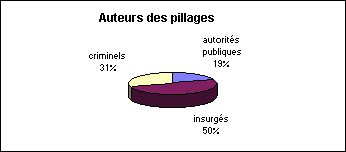
Les éléments de l’enquête révèlent une forte dominance des attaques contre logements et les bureaux. Compte tenu de l’extrême variété des activités menées par les ONG questionnées, il est hasardeux de dire que les objectifs des attaquants sont davantage politiques que crapuleux ou inspirés par le lucre. Mais il n’est pas exclu non plus que cette cible soit visée à la fois en sa qualité de centre de décision et de représentation de l’association et comme source de profits liés à la présence d’équipements coûteux (informatique, bureautique, communication).
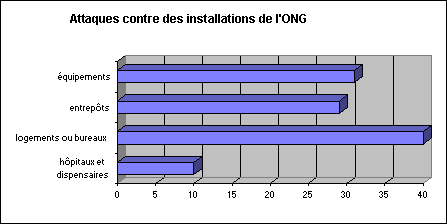
Les réponses fournissent les mêmes indications que pour ce qui concerne les dommages subis par les convois, à 2 ou 3% près. Ce qui est parfaitement cohérent dans la mesure où la vulnérabilité est sensiblement de même nature que les biens soient fixes ou mobiles.
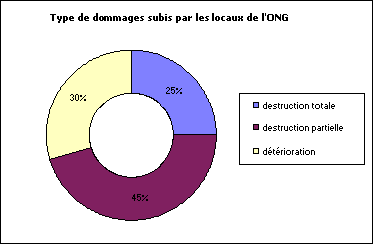
Le questionnaire invitait les associations consultées à fournir des renseignements quant aux arrestations, détentions et enlèvements; aux atteintes à l’intégrité, et aux causes de décès ou de blessures.
Les réponses relatives à la détermination des auteurs d’arrestations, de détentions et d’enlèvements ne concordent pas avec celles reçues à propos des convois et des locaux. Les criminels de droit commun y sont plus de deux fois moins fréquemment à l’origine de ces actes sur les personnels, les autorités étatiques et les insurgés faisant part égale avec respectivement 43 et 45%. Ce qui est aisément explicable par les modalités, la finalité et les conséquences de ces enlèvements qui sont davantage à la portée de structures à vocation politique et dotées d’un appareil organique et institutionnel doté d’un minimum de structure de pouvoir.

Ce sont évidemment les atteintes à l’intégrité qui sont les plus graves et celles qui suscitent les plus profondes préoccupations en matière de sécurité sur le terrain.
Les proportions entre les cinq catégories retenues sont d’autant plus alarmantes que les homicides qui arrivent en seconde position, après les traitements dégradants, sont très nombreux et forment, avec ces derniers, l’essentiel des atteintes.
La recherche de solutions de la part des ONG rejoint celle des organisations intergouvernementales, notamment celle des Nations Unies (note 3) ou celle de l’Union Européenne. Le constat des Nations Unies est transposable aux organisations non gouvernementales : « L’érosion du respect des normes humanitaires a provoqué une augmentation du nombre de victimes civiles; intensifié les besoins de protection et d’assistance des réfugiés et autres personnes touchées par un conflit; compliqué la fourniture de l’assistance humanitaire; et accru les risques auxquels se trouve confronté le personnel d’assistance humanitaire. »

Dominées par les tirs d’armes automatiques et les accidents, les causes de décès ou de blessures semblent suivre une répartition presque égale entre les agresseurs et les agressés en ce qui concerne les atteintes physiques subies. Cette conclusion serait hâtive et inexacte. En effet si la part d’accident peut, incontestablement être réduite par une meilleur préparation et une meilleure formation des agents des ONG envoyés sur le terrain (et on sait que presque toutes travaillent à l’élaboration et à l’enseignement de mesures préventives et de précaution (note 4)), il convient d’ajouter aux tirs d’armes automatiques, les bombardements, les mines antipersonnel, les mines antichar et les « diverses armes » qui ont en commun d’être utilisés ou déployés par une seule et même catégorie d’acteurs: les combattants.
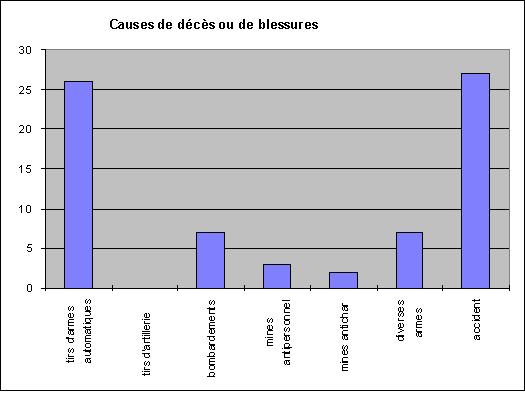
Les associations semblent attendre beaucoup du droit international car, manifestement, le sondage révèle un souhait largement partagé de voir modifier les règles juridiques élaborées par la communauté des États en vue d’un renforcement de la protection.
Pratiquement la moitié des associations qui ont répondu (48%) considère le statut de celles-ci comme insatisfaisant sur le plan de la sécurité. C’est relativement important et laisse supposer qu’une réflexion sur cette question devrait être poursuivie à l’U.A.I. ainsi qu’à l’échelon gouvernemental et intergouvernemental.
D’autant que seulement 42% d’entre elles pensent que ce statut est satisfaisant et 10% sont sans opinion. Cette observation est renforcée par les réponses à la question suivante posée dans le questionnaire.
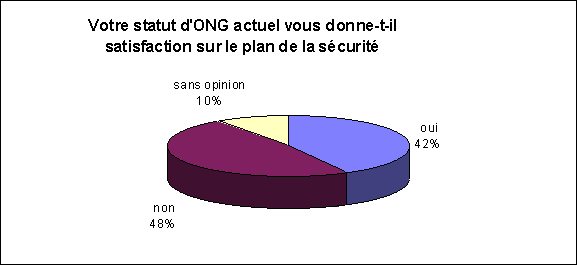
En effet, une forte proportion de réponses montre que c’est bien au niveau du statut international des ONG que les demandes d’aménagement juridique se font le plus profondément sentir. A l’intérieur de ce statut, il n’est pas surprenant de voir la hiérarchie des inquiétudes placer en tête la protection des personne, puis celle des biens et en dernier celle des transports.
En attendant des solutions normatives internationales qui seraient efficacement mises en oeuvre, les solutions empiriques risquent de demeurer longtemps les principales mesures envisageables. Reste alors à déterminer leur nature. Les unes peuvent être consensuelles; les autres peuvent mettre en jeu diverses forces.

En ce qui concerne la première méthode pragmatique. Elle a consisté assez fréquemment à négocier avec les autorités en présence et à trouver un accommodement, un rapprochement, une conciliation.
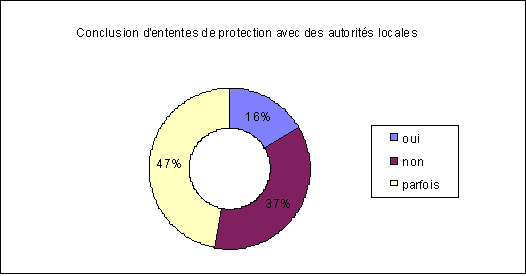
Le principe est en général celui de l’abstention. Les organisations humanitaires privées récusent toute collaboration avec des forces armées de quelques parties que ce soit. Un juriste, spécialiste du droit humanitaire affirmait en mai-juin 1992 : "Associé à une des forces armées en opposition ou couvert par elle, le CICR perdrait toute crédibilité dans son rôle d’intermédiaire neutre, et toute chance de pouvoir remplir ce rôle" (note 5).
La pratique, on le sait, a été toute différente. Près du tiers des ONG qui ont répondu (16% parfois +13% oui) ont affirmé avoir eu recours à la protection de milices privées. Il faut garder à l’esprit que dans les milieux proches du Secrétaire général de l’ONU, on s’est inquiété des effets induits d’une telle pratique (sursalaires versés par l’humanitaire à des bandes armées qui par ailleurs rançonnaient la population depuis longtemps; destruction des derniers morceaux du tissus social par des rétributions individuelles des miliciens bien supérieures à celles des fonctionnaires nationaux ou régionaux du pays; financement indirect du marché des armes...) Il paraît donc difficile de retenir cette pratique comme souhaitable, d’autant que le sondage montre qu’une forte majorité (71%) des associations en mission périlleuse questionnées n’en ont jamais fait usage.
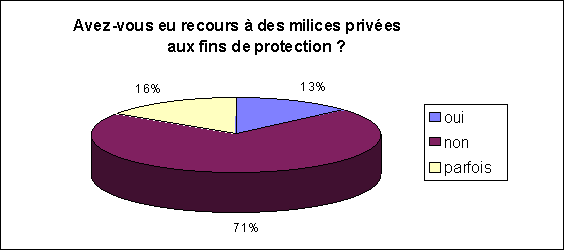
En parfaite cohérence avec les réponses aux questions précédentes, il est clair que c’est en ce qui concerne l’amélioration du statut des personnels que les associations souhaitent voir la Communauté internationale agir.
Il restera à déterminer, dans la suite des travaux du groupe, quels types d’immunités ou de privilèges il conviendrait d’établir et dans quelles limites on pourrait envisager des dispositions acceptables par toutes les parties aux conflits et aux situations de crises sources d’insécurité pour les agents de ces organisations.

Une des options figurant dans la question « F », aurait dû, en toute logique se situer sous la question « E ». En effet, à la suite d’une erreur de saisie, le F4 « inviolabilité de la personne » se trouve dans la rubrique de la protection des biens et non des personnes... Toutefois ce glissement est sans effet sur le résultat du questionnaire. Les réponses montrent bien qu’en toute cohérence, les organisations interrogées ont parfaitement situé leur priorité, à la fois dans la recherche d’une inviolabilité de la personne et de la protection des biens.
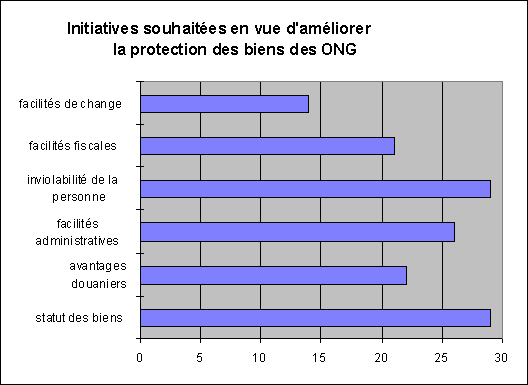
Conclusions
Les préoccupations exprimées par les associations dans les réponses au questionnaire - comme celles qui alertent depuis quelques années le CICR dont les travaux sur la matière sont importants - ne sont pas ignorées par les organisations intergouvernementales qui se mobilisent aujourd’hui de manière beaucoup plus systématique qu’autrefois sur ces questions de protection et de sécurité.
Toutefois les travaux sont conduits de manière un peu fractionnée ou dispersée à l’occasion d’activités que l’ONU ou l’Union européenne exercent dans un autre secteur tantôt à propos des ONG en mission périlleuse, tantôt à propos de la sécurité de leurs propres agents. Leurs observations ne sont pas toutes transposables aux questions étudiées par l’UAI, mais nombre d’entre elles sont transposables. Ainsi, aux Nations unies, un rapport du secrétaire général sur La sécurité du personnel de l’Organisation a été présenté à la Commission des droits de l’homme dans le cadre du point 8 de l’ordre du jour relatif aux questions des droits de l’homme de toutes les personnes soumises à une forme quelconque de détention ou d’emprisonnement.(note 6) Or on a vu ci-dessus (p. 61-62) que les mises en détention peuvent être le fait aussi bien d’insurgés que d’autorités gouvernementales. Ce rapport confirme la pertinence des recommandations formulées (pour ce qui concerne le personnel des Nations Unies) par Mme Bautista, Rapporteur spécial de la sous-commission de la lutte contre les mesures discriminatoires et de la protection des minorités (note 7)
Au niveau européen, ECHO a engagé un avant-projet d’étude soumis comme ballon d’essai à diverses ONG qui travaillent avec la Commission européenne (note 8) sur Security of relief workers and humanitarian space. Ce document a été présenté le 18 mai 1998 au Conseil des Ministres de l’Union Européenne en charge du Développement qui a statué sur la poursuite d’un débat relatif à la sécurité en concertation avec les États membres. Ce document a fait l’objet de commentaires divers de la part des organisations non gouvernementales. Il serait intéressant de mettre en commun les conclusions retenues avec celles issue des travaux de la Sous-Commission de l’O.N.U. dont plusieurs recommandations semblent transposables au domaine non-gouvernemental ou transnational. L’UAI envisage de confier au groupe de travail, la rédaction d’un projet de document qui tiendrait compte à la fois des réponses des ONG présentées et commentées ici et des diverses sources multilatérales.
References:
- Un peu moins d’une centaines de réponses ont été reçues. Les questionnaires ont été envoyés à 440 associations internationales, il y a eu 98 réponses, soit 22, 27%.
- Les pays ou situations concernés par ces 114 résolutions du Conseil de sécurité relatives à l’accès aux victimes sont: Afghanistan, Albanie, Angola, Burundi, ex-Yougoslavie, Géorgie, Golfe, Haut-Karabakh, Libéria, Mozambique, République centrafricaine, Rwanda, Sierra Leone, Somalie, Tadjikistan, Yémen, Zaïre.
- Cf. Rapport du secrétaire général sur la protection des activités d’assistance humanitaire aux réfugiés et autres personnes touchées par un conflit, S/1998/883 du 22 septembre 1998.
- Cf. Security in the field Information for staff members of the UN system, United Nations, New-York, 1998, 66p.
- SANDOZ (Yves) "Droit ou devoir d’ingérence, droit à l’assistance; de quoi parle-t-on ?" Revue Internationale de la Croix Rouge, n°795, mai-juin 1992, p. 231.
- E/CN.4/1998/33, 27 février 1998.
- E/CN.4 Sub.2/1992/19.
- ECHO working paper, Draft 8.2-19.2.98.
A study by the Union of International Associations (UIA): The following bibliographic resources are linked, in many cases, to the full text of the document.
Code of conduct of NGOs
- The Sphere Project: Humanitarian Charter and Minimum Standards in Disaster Response
- People in Aid Code of Good Practice
- Guidance for evaluating humanitarian assistance in complex emergencies, Development Assessment Committee, OECD (1999)
- Promoting norms to limit violence in crisis situations: challenges, strategies and alliances
Protection of NGOs
- Protection for non-governmental organisations on hazardous duties, Mario Bettati, UIA (1999)
- Partnerships in the protection of refugees and other people at risk: emerging issues and work in progress, Larry Minear, UNHCR Working Papers (July 1999)
- Forging Peace Conference Presentation (March 1998)
- The International Committee of the Red Cross as guardian of international humanitarian law, Yves Sandoz (1998)
- Development / Humanitarian NGOs and Conflict: A bibliography, Andrew Sherriff & Eeva Vaskio, International Alert (February 2000)
- Safety First: Protecting NGO employees who work in areas of conflict, Mark Cutts & Alan Dingle, Save the Children (1998)
- Peace & Security: Research Guide to International Law on the Internet
- NGOs and Complex emergencies: good intentions are not enough, Julia Taft, European Community Humanitarian Office (ECHO) News (December 1996)
- Protection for humanitarian assistance to refugees and others in conflict situations
- Statement by Ambassador Ernst Sucharipa, Permanent Representative of Austria on behalf of the European Union, New York (19 November 1998)
- The future of European humanitarian aid - the NGO view, VOICE (1999)
- The Psychological Health of Relief Workers: Some Practical Suggestions, Peter Salama (1999)
- Protecting Aid Workers: Prospects and Challenges. Forced Migration Projects (1997)
- The Changing Roles and Contributions of NGOs in Conflict and Humanitarian Efforts, Orrick White (May 2000)
- Conflict and Development: Responding to the challenge, World Vision (1998)
Security management by NGOs
- Planning between danger and opportunity: NGO situation analysis in conflict related emergencies, Hugo Slim (January 1996)
- NGO Field Security, Randolph Martin, Forced Migration Review (April 1999)
- Humanitarian Security: Challenges and Responses, Sean Greenaway & Andrew J. Harris
- Command Arrangements for Peace Operations, David S. Alberts & Richard E. Hayes, US National Defence University (May 1995)
- UNV Security Handbook
- Policy and practice: developments around aid agency security, RRN Newsletter (February 1998)
- Seminar on the security of humanitarian personnel in the field for non-governmental organisations (NGOs), International Committee of the Red Cross (December 1997)
Security training of NGO personnel
- Vulnerability Assessment: Training module for NGOs operating in Conflict Zones and High-Crime Areas, Jonathan T. Dworken, OFDA/InterAction PVO Security Task Force
- Recommendations for improving the security of humanitarian workers, Frank Schmidt
- As Violence Increases, NGOs Grapple With Security Training, InterAction, Monday Developments (January 2000)
- InterAction's Report of the Working Group on NGO Security Training Curriculum (1998-1999)
- Innovative Course Builds Skills For Enhancing NGO Security, InterAction, Monday Developments (March 1998)
- The changing shape of security for NGO field workers, Charles Rogers, World Vision (March 1998)
Partnerships of NGOs in hazardous situations
- Civil (NGO) - military cooperation: Lessons from Somalia, the former Yugoslavia, and Rwanda, André Beauregard, Ploughshares Monitor (December 1998)
- Humanitarian and Peace Operations: NGOs and the Military in the Interagency Process, Lisa Witzig Davidson, Margaret Daly Hayes, James J. Landon (December 1996)
- The Protection of United Nations and Associated Personnel and Humanitarian Personnel in Conflict Zones, Statement to Security Council by Australia (February 2000)
- Civilian Peace-Keepers - a Future Challenge, Christian Hårleman, ACCORD (2000)
- NGO/Military Cooperation in Complex Emergencies: The Need for Improved Coordination, Susan Finch (May 2000)
NGO security and international law
- International Humanitarian Law: The Challenge of Effective Implementation, Jim Carlton (July 1999)
- Human Rights and Humanitarian Law: what relief workers need to know, James Darcy, RRN Network Paper 19
- Human rights instruments and judicial reform, World Bank
- Selected Sections from International Treaties and Conventions Relevant to Personnel / Human Rights Practitioners
- Non-governmental human rights organizations and international humanitarian law (30 September 1998)
- Study on customary rules of international humanitarian law: Purpose, coverage and methodology
- Individual criminal responsibility for violations of international humanitarian law committed in non-international armed conflicts
Health of NGO personnel in emergency situations
- Security and stress management
NGO insurance and workers rights
- War-risk insurance cover for aid workers, Alistair Hallam, RRN Newsletter (February 1997)
Case studies
- Future political status of Kosovo, Frits Hondius, Council of Europe (March 1999)
- International Review of the Red Cross no 317 (April 1997)
- SPLM-United/OLS agreement on ground rules, Operation Lifeline Sudan (OLS)
- The Journal of Humanitarian Assistance, Department of Peace Studies, Bradford University, UK
- Accord Online Publications – Peacekeeping
- Civil Society Conference on the Priorities and Challenges for the Non-Aligned Movement in the Next Millennium (August 1998)
- Humanitarian assistance: a right or a policy?, Journal of Humanitarian Assistance (June 2000)
- 27th International Conference of the Red Cross and the Red Crescent (1999)
- Access to beneficiaries and security of humanitarian workers, Presentation: Mid-Term Reviews of the Consolidated Appeals, OCHA (July 2000)
- People on war: Answers to your questions
- The role of humanitarian issues in international politics in the 1990s
- Shifting sands: The search for ‘coherence’ between political and humanitarian responses to complex emergencies, Joanna Macrae & Nicholas Leader, Overseas
- Development Institute (August 2000)
- Rehabilitation in complex political emergencies: Is rebuilding civil society the answer?, Paul Harvey, IDS Working Paper 60
A study by the Union of International Associations (UIA). Links to organizations are, in many cases, provided below.
- RedR Engineers for Disaster Relief
- Humanitarian Safety and Protection Network (HSPN)
- Forum on Early Warning and Early Response (FEWER)
- Pacific Disaster Management Information Network (PDMIN)
- InterAction
- International Rescue Committee (IRC)
- Project Ploughshares
- Humanitarian Assistance Training Inventory (HATI)
- International Relations and Security Network (ISN)
- Humanitarian Practice Network (HPN)
- International Security Information Service (ISIS UK)
- Voluntary Organisations in Cooperation in Emergencies within the Liaison Committee of NGDOs to the European Union
- Active Learning Network for Accountability and Performance in Humanitarian Assistance (ALNAP)
- Working Group on Humanitarian and Emergency Assistance (WGHEA)
- Humanitarianism and War Project
- UN Disarmament, Demobilization and Reintegration Resource Centre
- WHO Division of Emergency and Humanitarian Action (EHA)
- NGO Coalition for an International Criminal Court
- NGO & UN Relations
- Committee to Protect Journalists
- Centre for Safety and Development
A study by the Union of International Associations (UIA): The following initiatives are linked to relevant web documents, which may also include links to other resources, including organizations and bibliographic material.
Developing codes of conduct: Specific to NGOs
- The Sphere Project: Humanitarian Charter and Minimum Standards in Disaster Response
- The People in Aid Code of Best Practice
- Guidance for evaluating humanitarian assistance in complex emergencies, Development Assessment Committee, OECD (1999)
- Promoting norms to limit violence in crisis situations: challenges, strategies and alliances
Developing UN-civil society relationships
- Final Report from the Millennium Forum Peace, Security and Disarmament Thematic Group (12 June 2000)
Developing codes of conduct: General
- The Code of Conduct for the International Red Cross and Red Crescent Movement and NGOs in Disaster Relief (February 1996)
- The Principles and Rules for Red Cross and Red Crescent Disaster Relief (February 1996)
Applying humanitarian law
- Protocol Additional to the Geneva Conventions of 12 August 1949, and relating to the Protection of Victims of International Armed Conflicts: Protocol 1 (December 1979)
- Protocol II: Protocol Additional to the Geneva Conventions of 12 August 1949, and Relating to the Protection of Victims of Non-International Armed Conflicts: Protocol II (1978)
- Universal Declaration of Human Rights 1948
- International Covenant on Civil and Political Rights 1966
- Selected Sections from International Treaties and Conventions Relevant to Personnel / Human Rights Practitioners
- Freedom of Association and Protection of the Right to Organize Convention (1948)
- International Human Rights Instruments
- Working Groups on the Right to Development
- Proclamation of Teheran (1968)
- Declaration on Social Progress and Development (1969)
- Declaration on the Right of Peoples to Peace (1984)
- Universal Declaration on the Eradication of Hunger and Malnutrition (1974)
- Declaration on the Human Rights of Individuals Who are not Nationals of the Country in which They Live (1985)
- Progress report of the Intergovernmental Group of Experts on the Right to Development on its first session (Geneva, 4-15 November 1996)
- Report on United Nations Commission on Human Rights: Fifty-third Session: Thematic Reports: Right to Development (10 March to 18 April 1997)
- 3rd International Security Forum. Networking the Security Community in the Information Age (October 1998)
- Working for solutions to crises: The development response, UNDP (1999)
- Convention on the Safety of United Nations and Associated Personnel (1994)
- Statutes for International Criminal Court (1998)
- European Commission on Security of Relief Workers and Humanitarian Space (18 May 1998)
- Security of Humanitarian aid workers: A concern at the heart of the EU’s humanitarian action (2010)
Related Vulnerable Social Agents
A study by the Union of International Associations (UIA): The following problems are linked to their descriptions in the UIA database. Access to the database is free, but requires login. The descriptions also provide extensive linking between these problems and to other problems in the database. They also include links to other resources, including strategies, organizations and bibliographic material.
Erosion of humanitarian agency neutrality in conflict situations J6974
Official harassment of nongovernmental organizations engaged in humanitarian works J7519
Threats to nongovernmental organizations engaged on hazardous duties J7004
Insecurity of nongovernmental personell engaged on hazardous duties J5698
Theft of nongovernmental organization assets during complex emergencies J6978
Kidnapping of nongovernmental staff engaged on hazardous duties J6051
Hijacking of nongovernmental transport engaged on hazardous duties J6866
Lack of legal protection for nongovernmental organizations engaged on hazardous duties J6145
Lack of security planning by nongovernmental organizations engaged on hazardous duties J7038
Lack of coordination among nongovernmental organizations engaged on hazardous duties J7237
Lack of United Nations coordination with nongovernmental organizations engaged on hazardous duties J6700
Killing nongovernmental organization personell engaged on hazardous duties J6133
Lack of cooperation between military and nongovernmental organizations engaged on hazardous duties J7024
Obstruction of nongovernmental organizations engaged on hazardous duties J7594
A study by the Union of International Associations (UIA): The following strategies are linked to their descriptions in the UIA database. Access to the database is free, but requires login. The descriptions also provide extensive linking between these strategies and to other strategies in the database. They also include links to other resources, including organizations and bibliographic material.
Protecting nongovernmental organisations engaged on hazardous duties J8261
- Protecting safety of nongovernmental organization staff engaged on hazardous duties J8790
- Protecting assets of nongovernmental organizations engaged on hazardous duties J7733
- Researching security issues faced by nongovernmental organisations engaged on hazardous duties J7674
- Developing security planning for nongovernmental organisations engaged on hazardous duties J8184
- Coordinating nongovernmental security arrangements for hazardous missions J8146
- Promoting nongovernmental cooperation on the issue of security in complex emergencies J7882
- Coordinating security arrangements for nongovernmental organizations with United Nations agencies J8386
- Coordinating security arrangements for nongovernmental organizations with national government authorities J8009
- Coordinating security arrangements for nongovernmental organizations with military forces J8909
- Developing emergency response procedures for nongovernmental organizations engaged on hazardous duties J8574
- Coordinating nongovernmental security arrangements for hazardous missions J8146
- Developing security training for nongovernmental organizations engaged on hazardous duties J7782
- Utilizing community acceptance for nongovernmental activities in hazardous operations J7960
- Developing operational policies & procedures for nongovernmental organizations engaged on hazardous duties J8571
- Using diplomatic deterrence to protect nongovernmental organizations engaged on hazardous duties J8587
- Providing information to nongovernmetal organizations engaged on hazardous duties J7737
- Developing security assessment procedures for nongovernmental organizations engaged on hazardous duties J8163
Establishing international legal protection for nongovernmental organisations engaged on hazardous duties J7453
- Promoting increased security protection for nongovernmental organisations engaged on hazardous duties J8459
- Promoting regional agreements to protect nongovernmental organizations engaged on hazardous duties J7943
- Establishing humanitarian neutrality of nongovernmental organizations engaged on hazardous duties J7844
- Establishing a human rights framework for nongovernmental organization operations in complex emergencies J8244
Protecting J8452
Protecting medical staff engaged on hazardous duties J8060
A study by the Union of International Associations (UIA): The following social agents face conditions of vulnerability analogous (if not identical) with those of NGOs and their personnel